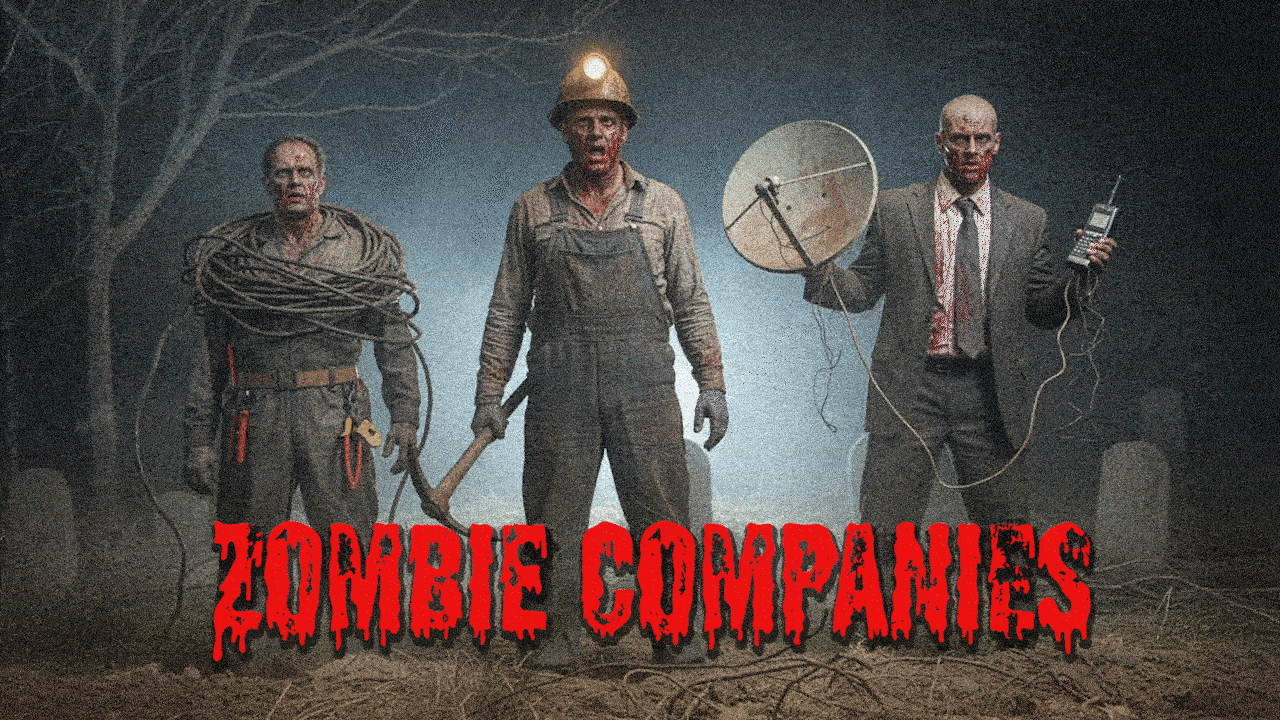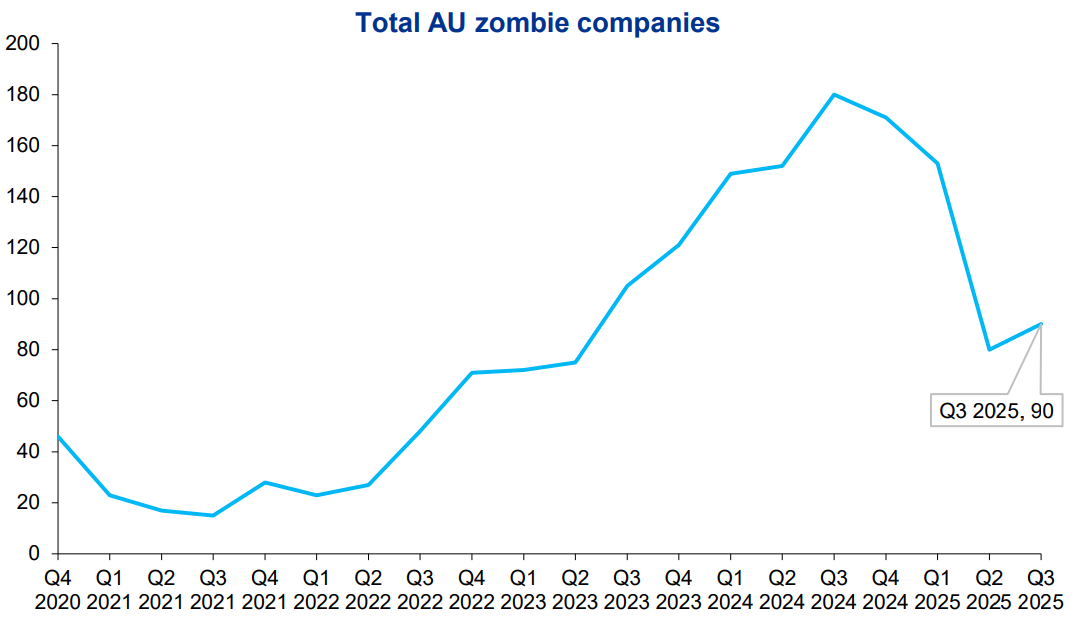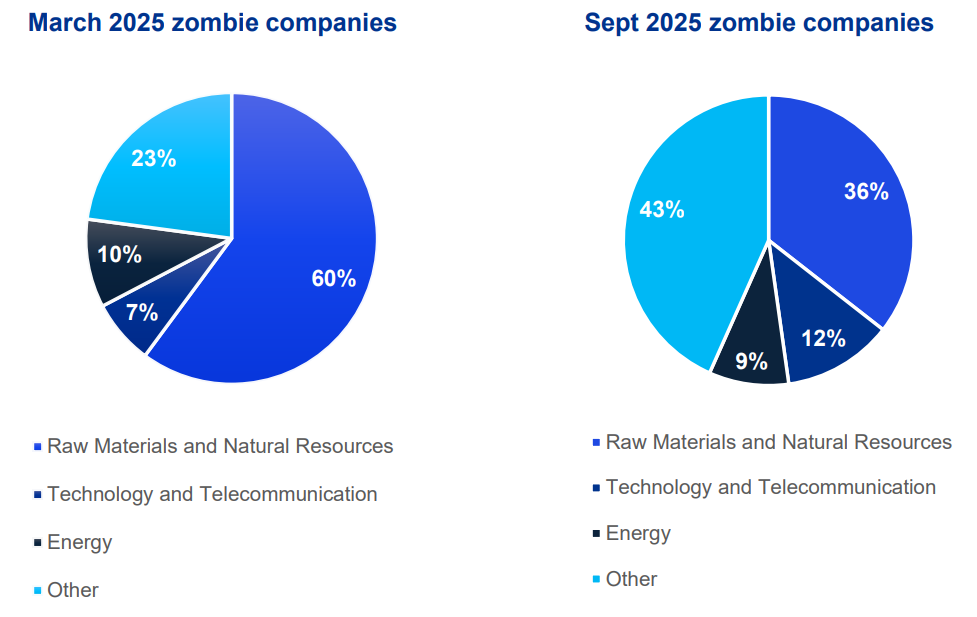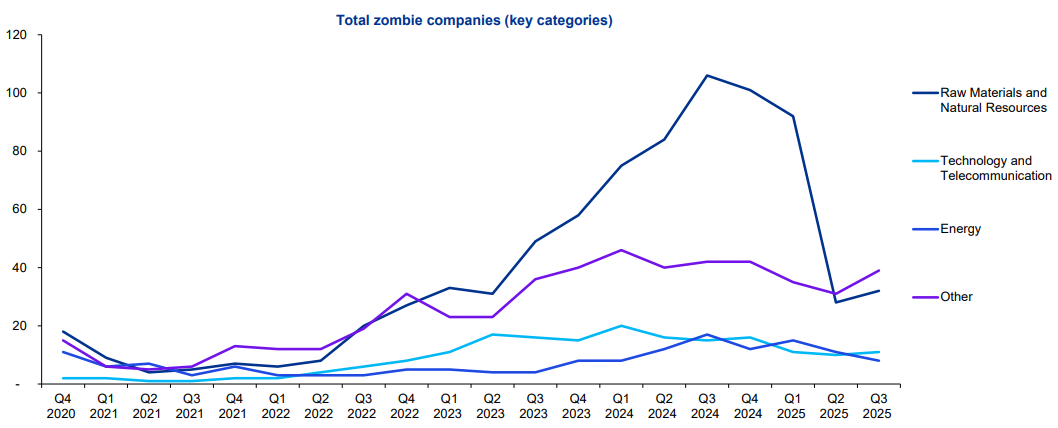What a 41% drop in struggling ASX firms says about the market
In markets, death is rarely final. Listed companies can continue to trade long after their earnings have flatlined, surviving only because they can meet interest repayments – but not reduce debt or generate real returns. These are the so-called “zombie companies.” And after reaching their peak in late 2024, they are finally in retreat.
Livewire readers may recall that in 2023, Coolabah Capital’s Christopher Joye drew attention to the rise of zombie companies due to the prevailing conditions at the time.
According to KPMG’s latest Zombie Companies Report (Q3 2025), the number of zombie companies on the ASX has fallen 41% over the past six months, dropping from 153 in March 2025 to 90 in September. That’s down from a high of 180 in September 2024, marking the most significant turnaround since the pandemic.
This shift comes as tighter credit conditions, improved market valuations, and stronger consumer sentiment have given more businesses the runway they need to stabilise. Meanwhile, rising commodity prices have helped eliminate distress among miners and energy producers, with renewed capital flowing into critical minerals, gold and iron ore.
Gayle Dickerson, Head of Turnaround & Restructuring at KPMG, says growth in stock market valuations, lower interest rates, and improved confidence are giving businesses the breathing room to stay solvent.
“This improvement remains delicate with ongoing geopolitical risk remaining a threat to global markets and interest rates may hold or even potentially rise in the next 12 months as inflation remains sticky.”
According to the KPMG report, investor interest in rare earths, along with increases in gold and iron ore prices, has helped see capital flow into the resources sector, eliminating many distressed companies. This is not just a cyclical bounce. It’s a structural shift in market leadership.
Below is a summary of the paper's key points. The full version can be downloaded at the bottom of the wire.

SUMMARY OF KEY POINTS
Zombies in decline: a turning point for market health
As illustrated in Slide 2 of the KPMG report (chart available below), zombie companies peaked in Q3 2024 at 180 firms, then fell to 153 in March 2025, and plummeted to 90 by September.
- Zombie count: 90 in Q3 2025 (down 41% in six months)
- Zombie share of listed companies: down to 6%
- Zombie market cap: halved to $562 million
This decline coincides with stronger equity market performance and improving investor risk appetite.
“This improvement remains delicate with ongoing geopolitical risk remaining a threat to global markets and interest rates may hold or even potentially rise,” Dickerson cautions.

Resources sector leads the resurrection
Slide 4 of the report (chart available below) shows that raw materials and natural resources account for 36% of remaining zombies, but more importantly, they account for the majority of companies exiting distress over the past year.
The KPMG report notes:
“Investor interest in rare earths, as well as increases in gold and iron ore prices, have helped see capital flow into the sector, eliminating many distressed companies.”
This has shifted the resources sector from the epicentre of distress to the engine of recovery.
According to the KPMG report, Western Australia is home to the largest concentration of remaining zombie companies, with 35 of the 90 headquartered there.
This aligns with WA’s heavy exposure to resources, a sector where distressed company numbers have been falling as commodity prices improve.
Investor takeaway: Expect further earnings upgrades in the mid-cap mining and energy segments.

Technology finds stability as AI capital flows in
While the number of technology and telecommunications zombies remained steady at 11 companies (12% of the total), KPMG reports a significant improvement in valuation and earnings outlook.
Lower interest rates and AI-driven infrastructure investment have boosted balance sheets.
According to the KPMG report, global market confidence has been buoyed by easing trade tensions, record equity market highs, and a surge in AI-related investment, particularly in data centre infrastructure.
Investment implication: capital is rewarding technology firms with real earnings and infrastructure exposure, not speculative software names.

Healthcare and manufacturing: new epicentres of distress
While most sectors are improving, healthcare is deteriorating. According to the KPMG report, zombie numbers in the sector have risen from two companies in 2020, to seven in 2025.
“Healthcare sector is facing soaring costs and labour shortages along with an increased prevalence of short stay and same-day admissions. It’s caused them to seek increased Private Health Insurance (PHI) contributions well beyond what the insurers are willing to contribute leading to significant distress across the sector,” explains Gayle Dickerson.
Manufacturing is experiencing similar pressures, with zombie numbers tripling since 2020.
Investor warning: defensive sectors are no longer immune. Companies lacking scale or pricing power face sustained margin pressure.
Global zombie numbers rising – Australia a relative winner
The KPMG report highlights that while zombies are declining in Australia, the global zombie count has increased by 8.1% over the past year to 1,435 companies.
Globally, raw materials (19.2%), technology (12.4%) and biotechnology (11.5%) account for the largest share.
Australia’s resilience, according to the report, is attributable to commodity exposure, private credit availability and proactive refinancing frameworks.
“Australia should not rest on its laurels as we could see the levels of zombies return with an increase in interest rates or disruption in stock markets,” Dickerson warns.
The zombies are falling – but not everywhere
KPMG’s findings confirm a major turning point for the ASX. Distress is collapsing in cyclical sectors, capital is returning to resource and technology names, and market sentiment is strengthening. But a new front has opened in healthcare and manufacturing, where structural cost pressures are rising.
Investor positioning:
- Opportunity: mid-cap resources and AI-linked infrastructure plays
- Selective upside: profitable tech with capital discipline
- Risk zones: healthcare and manufacturing without pricing power
- Macro watchpoint: interest rates remain the key trigger for the next wave of distress
The ASX may be coming back to life but remember, not every company will survive the next cycle.

3 topics
1 contributor mentioned
